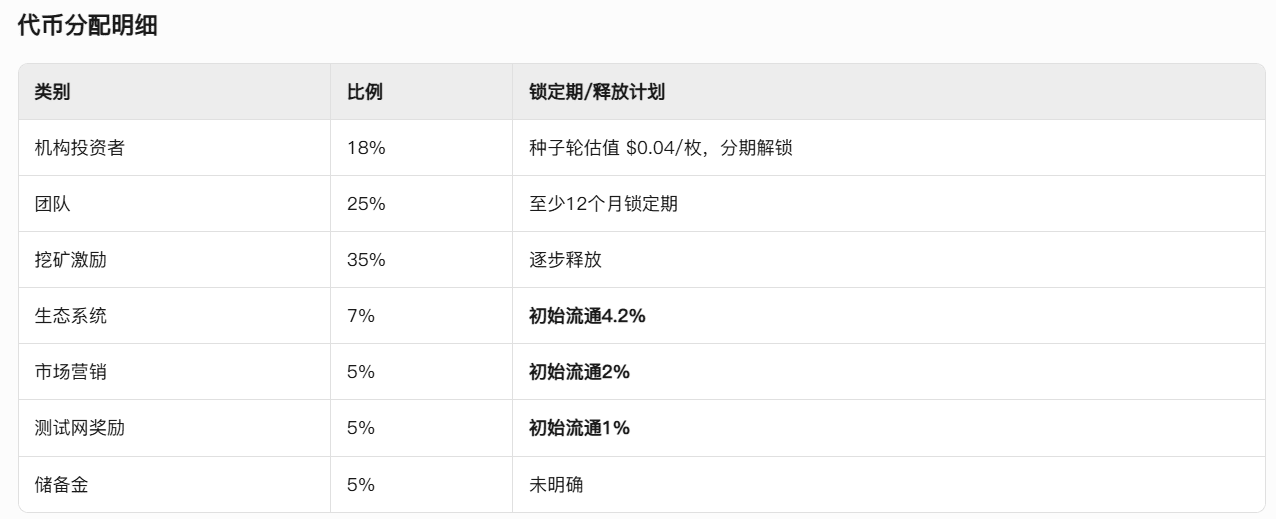One, project overview
DePHY Network is a full-stack framework designed for DePIN (Decentralized Physical Infrastructure Network), aimed at reducing development costs and time through the following core components:
Open-source hardware solutions: Provide standardized hardware modules to lower the threshold for devices to go on-chain.
Decentralized messaging layer: Based on TEE (Trusted Execution Environment) and ZK (Zero-Knowledge Proof) technology, achieving 500ms-level low-latency communication and data verifiability.
Automated token economics: Incentive distribution executed automatically through smart contracts, supporting device providers, node operators, and data contributors.
Key progress:
Seed round financing: Completed several million dollars in financing, valuation
40 million dollars, investors include Foresight Ventures, IoTeX, Waterdrip Capital, etc.Technical endorsement: Funded by the Solana Foundation, the technical architecture is deeply compatible with the Solana ecosystem (low gas fees, Rust language support).
Two, token economics
Total token supply: 1 billion $PHY
Initial circulation: 7.2% (72 million tokens)

Initial circulation composition analysis
Binance wallet reception: 6% of tokens (including airdrop and liquidity provision).
Estimated circulation distribution:
Testnet airdrop: about 1% (no public claim information, conservatively estimated)
Exchange liquidity: Binance Alpha accounts for 1.5%, other platforms (such as Bitget/MEXC) account for 0.5%
Ecosystem fund: 4.2% (for liquidity pools and partner incentives)
Three, exchange listing details
Binance Alpha: July 26 at 16:00
(UTC+8) opens for trading.
Bitget & MEXC: Launching simultaneously on July 26 at 16:00 (UTC+8).
Four, on-chain contract address
BSC chain: 0xD029B392580d555F35CCa1987f27D248cF883716
Solana chain: DEpHYkW6nEm3Sxhb2rwftatrSAV3AP3ac6MgAWBbnsS8
Five, analysis of circulating tokens and potential selling pressure
Initial circulation distribution
Project party controls tokens: ecosystem fund (4.2%)
Long-term locked tokens: Unreleased marketing part (0.5%) + remaining testnet (1%) = 1.5%
Short-term selling pressure source: Marketing has released part (1.5%)
Selling pressure driving factors
DePIN business model: Currently, most projects rely on a 'mining-selling' cycle, leading to continuous token selling pressure.
Insufficient community activity: Official social media and testnet participation is low, lacking ecological construction motivation.
Six, core advantages and risks of the project
Advantages
Technical differentiation:
AI-native architecture: Real-time data collection achieved through dynamic data coordination protocol (MCP), enhancing AI model training efficiency.
Trinity solution: Integrating hardware, distributed networks, and DApps to avoid ineffective device piling.
Low circulation startup: Initial circulation is only 7.2%, and if demand is strong, it may push prices up in the short term.
Risks
Commercialization progress lagging: Insufficient sales and promotion of hardware devices, relying on token incentives rather than actual demand.
Weak community foundation: Compared to competitors (like IoTeX), user interaction and developer activity are significantly lacking.
Valuation pressure: Seed round valuation 0.04, if listing price > 0.1 (corresponding to fully diluted valuation of $100 million), lacking fundamental support.
Seven, investment perspective
Neutral view: Short-term price fluctuations may be affected by low circulation, but long-term value needs observation:
Device landing progress (such as cooperation in energy and environmental monitoring fields).
Token consumption scenario: Whether to build demand-side applications such as data markets or computing resource leasing.
Operational strategy:
Neither long nor short suitable: Low circulation limits short selling space, high valuation and selling pressure suppresses long motivation.
Observation indicators: Pay attention to large on-chain transfers, changes in exchange positions, and ecological cooperation announcements.
Appendix: Data sources
Token model: Project white paper, RootData
On-chain data: BscScan, SolScan
Market dynamics: CoinMarketCap, official Twitter
Technical architecture: [DePHY Network Technical Documentation]
Disclaimer: This report is based on public information analysis and does not constitute investment advice. The cryptocurrency market is highly volatile; please assess risks cautiously.
